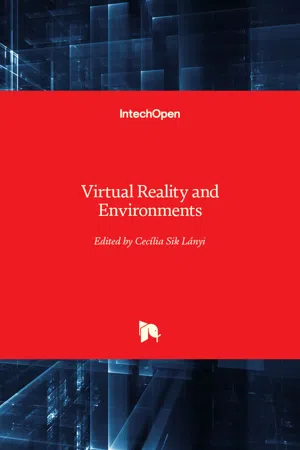
- 218 pages
- English
- PDF
- Available on iOS & Android
Virtual Reality and Environments
About this book
Virtual Reality is clearly interdisciplinary research. It has, not only Information Technology importance but social, educational, economical importance too. It combines multiple disciplines for the development of virtual reality systems in which the user has the immersive feeling of being in the real world. Virtual reality has several applications in almost all fields of real life. The most typical fields for the application of virtual reality are health-care, engineering and game industry. This book may be a solid basis for the novice and advanced engineers who would like to develop user friendly Virtual Environments for education, rehabilitation and other applications of Virtual Reality. Our book provides a resource for wide variety of people including academicians, designers, developers, educators, engineers, practitioners, researchers, and graduate students.
Frequently asked questions
- Essential is ideal for learners and professionals who enjoy exploring a wide range of subjects. Access the Essential Library with 800,000+ trusted titles and best-sellers across business, personal growth, and the humanities. Includes unlimited reading time and Standard Read Aloud voice.
- Complete: Perfect for advanced learners and researchers needing full, unrestricted access. Unlock 1.4M+ books across hundreds of subjects, including academic and specialized titles. The Complete Plan also includes advanced features like Premium Read Aloud and Research Assistant.
Please note we cannot support devices running on iOS 13 and Android 7 or earlier. Learn more about using the app.
Information
Table of contents
- Virtual Reality and Environments
- Contents
- Preface
- Chapter 1 Virtual Environments in Physical Therapy
- Chapter 2 A Survey of Some Virtual Reality Tools and Resources
- Chapter 3 Training of Procedural Tasks Through the Use of Virtual Reality and Direct Aids
- Chapter 4 The Users’ Avatars Nonverbal Interaction in Collaborative Virtual Environments for Learning
- Chapter 5 ROTATOR Model: A Framework for Building Collaborative Virtual Workspaces
- Chapter 6 Optical Touch Screen and Its Application as a Next Generation Classroom Response System
- Chapter 7 Personalization of Virtual Environments Navigation and Tasks for Neurorehabilitation
- Chapter 8 Vision for Motor Performance in Virtual Environments Across the Lifespan
- Chapter 9 Ergonomics Design Criteria of a Virtual Environment
- Chapter 10 The Virtual Reality of Work – How to Create a Workplace that Enhances Well-Being for a Mobile Employee